Contents
Chicken and cabbage soup is a comforting, hearty dish that combines tender chicken with the natural crunch of cabbage and a medley of flavorful vegetables. It’s not just a meal; it’s a warm hug in a bowl. Whether you’re looking to create a nutritious meal that’s easy to prepare or are exploring various ways to incorporate different flavors into a traditional soup, this guide will walk you through everything you need to know. From its health benefits and essential ingredients to variations from around the world, we’ll cover all the bases to help you create the best chicken and cabbage soup for any occasion.
Introduction to Chicken and Cabbage Soup
What is Chicken and Cabbage Soup?
Chicken and cabbage soup is a simple yet satisfying dish made by combining chicken with cabbage, along with other vegetables and seasonings, all simmered in a broth. It’s a versatile soup, allowing you to play around with the ingredients depending on your preferences or dietary restrictions.
The star ingredients—chicken and cabbage—come together to create a flavorful, balanced soup that can be enjoyed as a main course or as part of a healthy meal plan. The soup can vary based on the region, adding cultural nuances with different spices, herbs, and techniques. It’s loved worldwide for its comforting warmth and wholesome nature, making it a perfect meal during the cooler months or whenever you’re in the mood for something light yet filling.
Health Benefits of Chicken and Cabbage Soup
One of the best things about chicken and cabbage soup is that it’s packed with health benefits. Not only is it incredibly nourishing, but it’s also an excellent option for anyone trying to eat a balanced, low-calorie meal.
Nutritional Profile
Chicken provides a high-quality protein source, crucial for building and repairing tissues, supporting immune function, and maintaining muscle mass. Cabbage, on the other hand, is loaded with fiber, vitamin C, and antioxidants, which help in digestion, boost your immune system, and promote healthy skin.
Weight Management
Thanks to its low-calorie content, cabbage soup is often included in weight-loss plans. The combination of lean chicken and fiber-rich cabbage fills you up, preventing overeating. Additionally, cabbage contains compounds that can help detoxify the body, supporting weight management and reducing inflammation.
Immune Support
Both chicken and cabbage are immune-boosting powerhouses. Chicken provides zinc, which is essential for maintaining a healthy immune system, while cabbage is packed with vitamin C, a key nutrient for fighting off illnesses and boosting your body’s defenses.
Chicken and cabbage soup is more than just a delicious meal; it’s a great choice for anyone looking to eat healthy and stay strong.
Ingredients and Preparation
Essential Ingredients
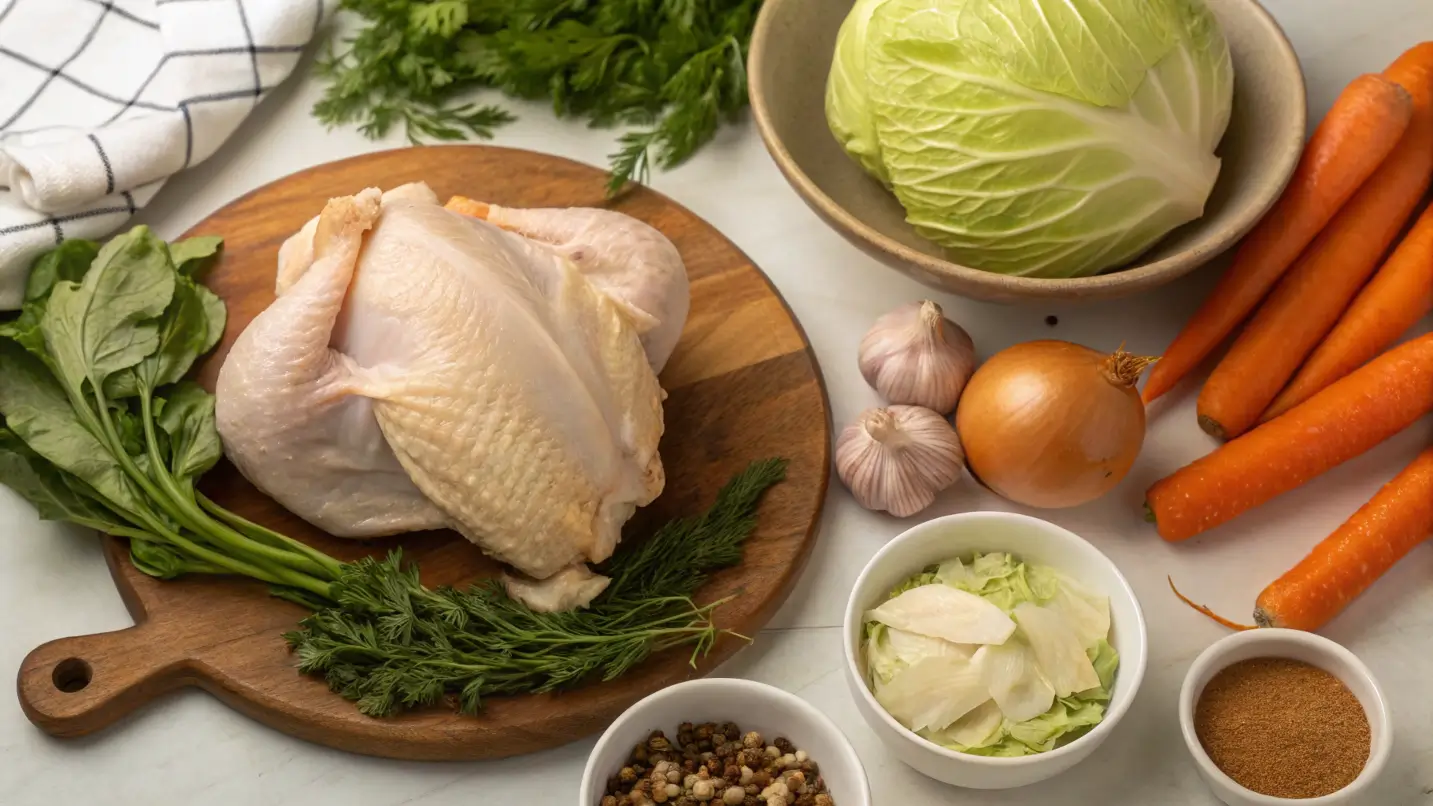
When making chicken and cabbage soup, the ingredients you choose will set the tone for the entire dish. Here’s a breakdown of the essential components and tips on selecting the best options for each.
Chicken: Choosing Between Breasts, Thighs, or Rotisserie Chicken
The first and most important ingredient is the chicken. You have a few options here, and each will give the soup a slightly different flavor and texture.
-
Chicken Breasts: Skinless, boneless chicken breasts are a lean choice and will provide a mild, tender texture. They cook quickly and can be shredded easily after simmering in the broth.
-
Chicken Thighs: If you want a richer flavor and a slightly fattier texture, chicken thighs are your best bet. Bone-in thighs offer more flavor, while boneless thighs provide convenience. They’ll also hold up better during longer cooking times, staying juicy and tender.
-
Rotisserie Chicken: For a shortcut, rotisserie chicken is a great choice. The pre-cooked chicken adds an instant depth of flavor to your soup. Just shred it and add it to the broth near the end of cooking.
Cabbage: Selecting the Right Type and Preparation Tips
Cabbage is the heart of the soup, and there are different types to choose from. Here’s a guide to selecting the best cabbage for your soup:
-
Green Cabbage: The most common type, green cabbage, has a mild flavor and tender texture when cooked. It’s ideal for a traditional chicken and cabbage soup.
-
Napa Cabbage: Napa cabbage is softer and has a slightly sweet flavor. It works well in lighter, Asian-inspired soups.
-
Savoy Cabbage: With curly leaves and a more delicate texture, savoy cabbage is perfect if you’re looking for a slightly more refined version of the soup.
When preparing cabbage, make sure to remove the tough outer leaves, then slice it into thin ribbons or chop into bite-sized pieces. This will allow the cabbage to cook down nicely and blend well with the other ingredients.
Vegetables: Incorporating Carrots, Celery, Onions, and Potatoes
To round out the soup, you’ll need a variety of vegetables. Classic choices include:
-
Carrots: They add a slight sweetness and vibrant color to the soup. Slice them thinly or chop them into chunks for easy eating.
-
Celery: Known for its subtle, peppery flavor, celery adds a fresh crunch and enhances the broth.
-
Onions: Onions are essential for flavor building. Sauté them at the beginning to create a savory foundation for the soup.
-
Potatoes: Potatoes add heartiness to the soup, making it more filling. You can use Russet or Yukon Gold potatoes, and chop them into bite-sized cubes for easy cooking.
Aromatics and Spices: Utilizing Garlic, Ginger, Turmeric, and Herbs for Depth of Flavor
Aromatic ingredients and spices are key to enhancing the soup’s flavor profile. Here are some excellent choices:
-
Garlic: Adds a pungent, savory base that pairs well with the chicken and vegetables.
-
Ginger: Fresh ginger adds warmth and a subtle zing, especially if you’re going for an Asian or fusion version of the soup.
-
Turmeric: A pinch of turmeric gives the soup a beautiful golden color and an earthy flavor, especially if you’re making a curry-inspired version.
-
Herbs: Fresh herbs like thyme, rosemary, or bay leaves lend complexity and a fragrant touch. You can also use dried herbs if fresh ones aren’t available.
Preparation Steps
Now that you’ve gathered all the ingredients, it’s time to get cooking! Follow these preparation steps to ensure that your chicken and cabbage soup turns out perfectly every time.
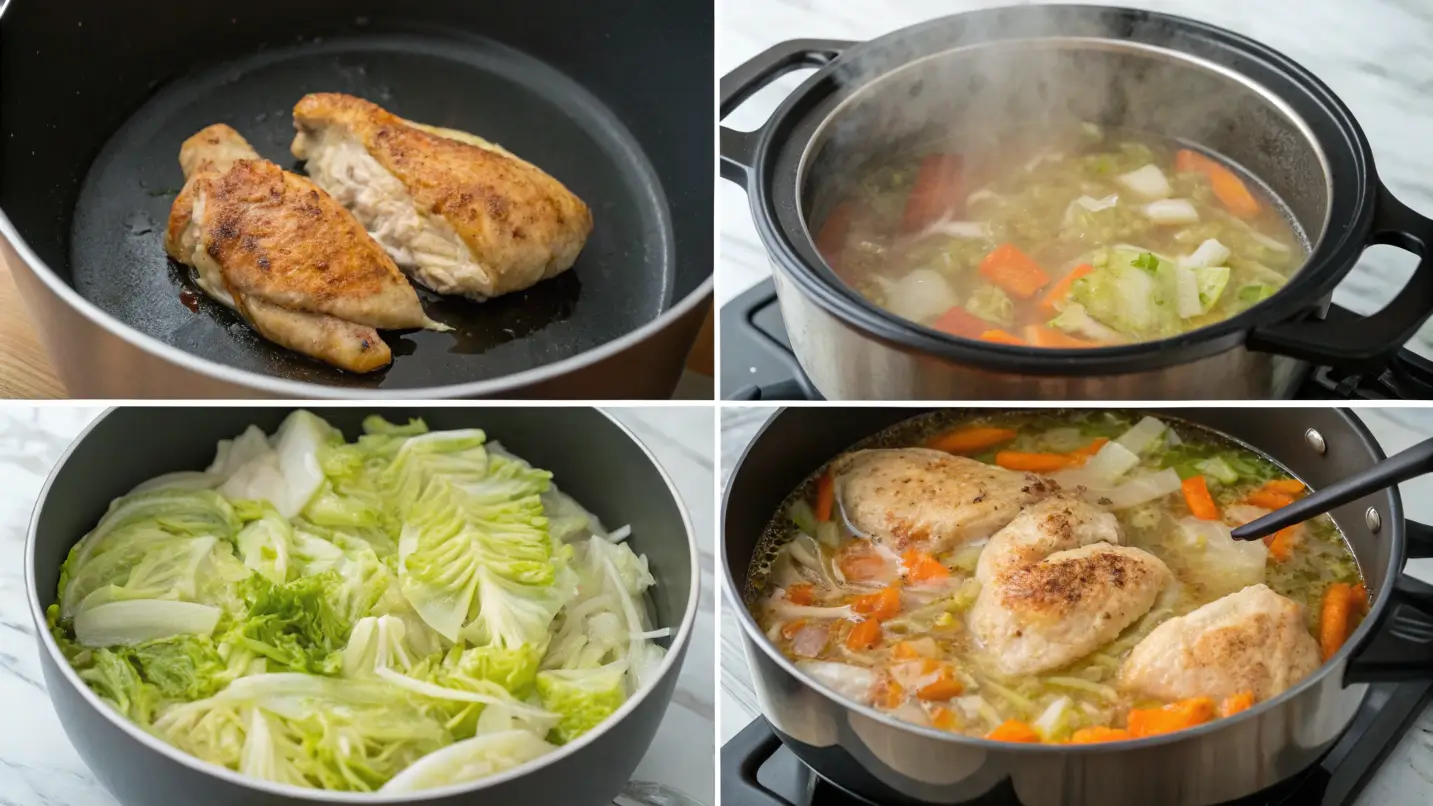
Cooking the Chicken: Methods for Boiling, Roasting, or Using Leftover Chicken
There are several ways to cook the chicken for your soup, depending on how much time you have.
-
Boiling the Chicken: Start by adding chicken breasts or thighs (bone-in or boneless) to a large pot of water, along with aromatics like onion, garlic, and herbs. Bring it to a simmer and cook until the chicken is tender and cooked through, which will take about 20-30 minutes. Once done, remove the chicken and shred it before adding it back to the soup.
-
Roasting the Chicken: If you want extra flavor, roast the chicken first. Season the chicken with your favorite spices and roast it at 375°F (190°C) until the skin is golden and the meat is cooked through (about 40 minutes). Once roasted, shred the chicken and add it to your soup.
-
Using Leftover Chicken: If you have leftover rotisserie chicken or any cooked chicken, simply shred it and add it to the soup in the last 10 minutes of simmering. This will allow the chicken to soak in the broth without overcooking.
Vegetable Preparation: Proper Chopping and Sautéing Techniques
Prepare your vegetables by chopping them into even-sized pieces to ensure uniform cooking. Start by sautéing onions, carrots, and celery in a bit of oil or butter to create a savory base. Sauté the vegetables until they are tender and aromatic—about 5 minutes—before adding the potatoes and cabbage.
-
Sautéing: Cooking the vegetables in a hot pan helps release their flavors. Be sure not to burn them, as this can impart a bitter taste. Stir occasionally until the onions become translucent and the other veggies soften slightly.
Simmering the Soup: Layering Flavors and Achieving the Perfect Broth Consistency
Once all your ingredients are prepped, it’s time to simmer everything together. Add the sautéed vegetables to your chicken broth or stock, followed by the shredded chicken. Allow the soup to simmer for at least 30 minutes, letting the flavors meld together. As it simmers, the cabbage will break down and soften, infusing the broth with a rich, savory flavor.
If you prefer a thicker soup, you can mash a few of the potatoes to create a more substantial texture. For a thinner, broth-based soup, feel free to adjust the amount of liquid by adding more broth or water as needed.
Taste the soup and adjust the seasoning, adding salt, pepper, and any additional herbs or spices to suit your preferences. For extra depth, a splash of vinegar or lemon juice can balance the flavors.
Variations of Chicken and Cabbage Soup
Regional Variations
Chicken and cabbage soup is a global dish that can be adapted to reflect the flavors and ingredients of different cultures. Here’s how you can modify the soup to bring in regional twists.
Eastern European Influence: Incorporating Ingredients Like Potatoes and Dill
Eastern European versions of chicken and cabbage soup often incorporate hearty, starchy ingredients like potatoes, which add body and texture to the broth. The addition of fresh dill, a herb commonly used in Eastern European cooking, gives the soup a bright, slightly tangy flavor that balances out the richness of the chicken.
-
Potatoes: Chop potatoes into bite-sized cubes and add them early in the simmering process. They’ll absorb the flavors of the broth while adding substance to the soup.
-
Dill: Fresh dill adds an aromatic, slightly grassy note to the soup. Add it toward the end of cooking so it retains its vibrant flavor, or use dried dill for a more subdued effect.
This version of chicken and cabbage soup is particularly comforting during the colder months, offering a hearty, flavorful meal that’s perfect for sharing with family or friends.
Asian Twist: Adding Ginger, Garlic, and a Splash of Vinegar for a Tangy Profile
An Asian-inspired chicken and cabbage soup introduces aromatic spices and flavors like ginger, garlic, and vinegar for a tangy, flavorful broth. The result is a light but bold soup that’s perfect for those who prefer vibrant, aromatic flavors in their meals.
-
Ginger and Garlic: Fresh ginger and garlic provide a fragrant and slightly spicy base that complements the other ingredients. Slice or grate the ginger and mince the garlic, then sauté them with onions and other vegetables to create a rich flavor base.
-
Vinegar: A splash of rice vinegar or white vinegar can bring a sharp tang to balance the richness of the chicken and cabbage. This will give your soup a refreshing twist.
-
Soy Sauce: For added umami, consider adding a dash of soy sauce, which gives the broth a deep, savory flavor profile.
This version is especially popular in countries like China, Japan, and Korea, where soups are often light yet packed with complex flavors.
For a flavorful variation, try adding ginger, garlic, and vinegar to give the soup a tangy twist. If you’re interested in more Asian-inspired soups, check out our Asian Noodle Soup recipe.
Mexican Flair: Introducing Spices Like Cumin and Chili, and Serving with Lime and Cilantro
For a bold, spicy version of chicken and cabbage soup, turn to Mexican flavors. Cumin, chili powder, and lime transform this simple soup into a zesty, full-bodied dish that’s perfect for anyone who loves a bit of heat.
-
Cumin and Chili Powder: These spices add warmth and depth to the broth. Start with a small amount and gradually add more to adjust to your spice tolerance.
-
Lime and Cilantro: Fresh cilantro and a squeeze of lime juice bring a burst of freshness and acidity that cuts through the richness of the chicken and cabbage. Serve the soup with lime wedges on the side for added zing.
-
Jalapeños or Chipotle: If you’re craving even more heat, add chopped jalapeños or a dash of chipotle in adobo for a smoky kick.
This Mexican-inspired variation is ideal for those who love bold, spicy flavors and want a bit of a departure from the traditional chicken and cabbage soup.
If you’re looking for more chicken dishes, try this Million Dollar Chicken Casserole or this Garlic Parmesan Chicken Pasta for a flavorful twist on your meal planning.
Dietary Adaptations
Chicken and cabbage soup is versatile, making it easy to adjust for different dietary needs. Here are a few adaptations to suit specific diets.
Low-Carb and Keto: Reducing Starchy Vegetables and Using Alternative Thickeners
For those following a low-carb or keto diet, you can modify chicken and cabbage soup by reducing or eliminating starchy vegetables like potatoes and carrots. Instead, focus on low-carb vegetables and use alternative thickeners to give the soup a satisfying texture.
-
Low-Carb Vegetables: Swap potatoes for cauliflower, zucchini, or turnips, which are low in carbs but still add bulk and texture to the soup. You can also add extra cabbage or leafy greens like spinach or kale.
-
Alternative Thickeners: If you prefer a thicker soup, blend part of the cabbage or use cream cheese or heavy cream to achieve a rich consistency without the carbs. You can also use a small amount of xanthan gum or guar gum as a low-carb thickening agent.
This version of chicken and cabbage soup will be perfect for anyone looking to keep their carb intake low while still enjoying a filling and flavorful meal.
Gluten-Free: Ensuring All Ingredients and Seasonings Are Gluten-Free
Chicken and cabbage soup is naturally gluten-free, but it’s important to check that all ingredients you use are free from gluten-containing additives.
-
Broth and Seasonings: Make sure that your chicken broth, seasonings, and any store-bought products (such as soy sauce or spices) are labeled gluten-free. Some soy sauces and seasonings may contain wheat, so look for gluten-free versions to ensure the soup remains safe for those with gluten sensitivity.
-
Thickeners: If you use a thickener for the soup, such as cornstarch or arrowroot powder, double-check that it is gluten-free. Most naturally gluten-free thickeners are safe to use, but it’s always good to confirm.
With a little attention to ingredients, you can make a gluten-free version of this soup that’s just as satisfying and flavorful as the original.
Vegetarian Option: Replacing Chicken with Plant-Based Proteins and Vegetable Broth
For a vegetarian take on chicken and cabbage soup, simply omit the chicken and use plant-based alternatives to create a soup that’s equally hearty and flavorful.
-
Plant-Based Proteins: You can replace chicken with a plant-based protein like tofu, tempeh, or chickpeas. Tofu is especially versatile and absorbs the flavors of the broth well. Tempeh has a nuttier texture that works beautifully in soups. If you prefer beans, use white beans or lentils as a substitute.
-
Vegetable Broth: Use vegetable broth instead of chicken broth to maintain the flavor depth without the meat. Be sure to select a high-quality vegetable broth for the best taste.
This version is perfect for those who follow a vegetarian or vegan diet but still want to enjoy a nutritious and filling soup.
Cooking Tips and Techniques
Enhancing Flavors
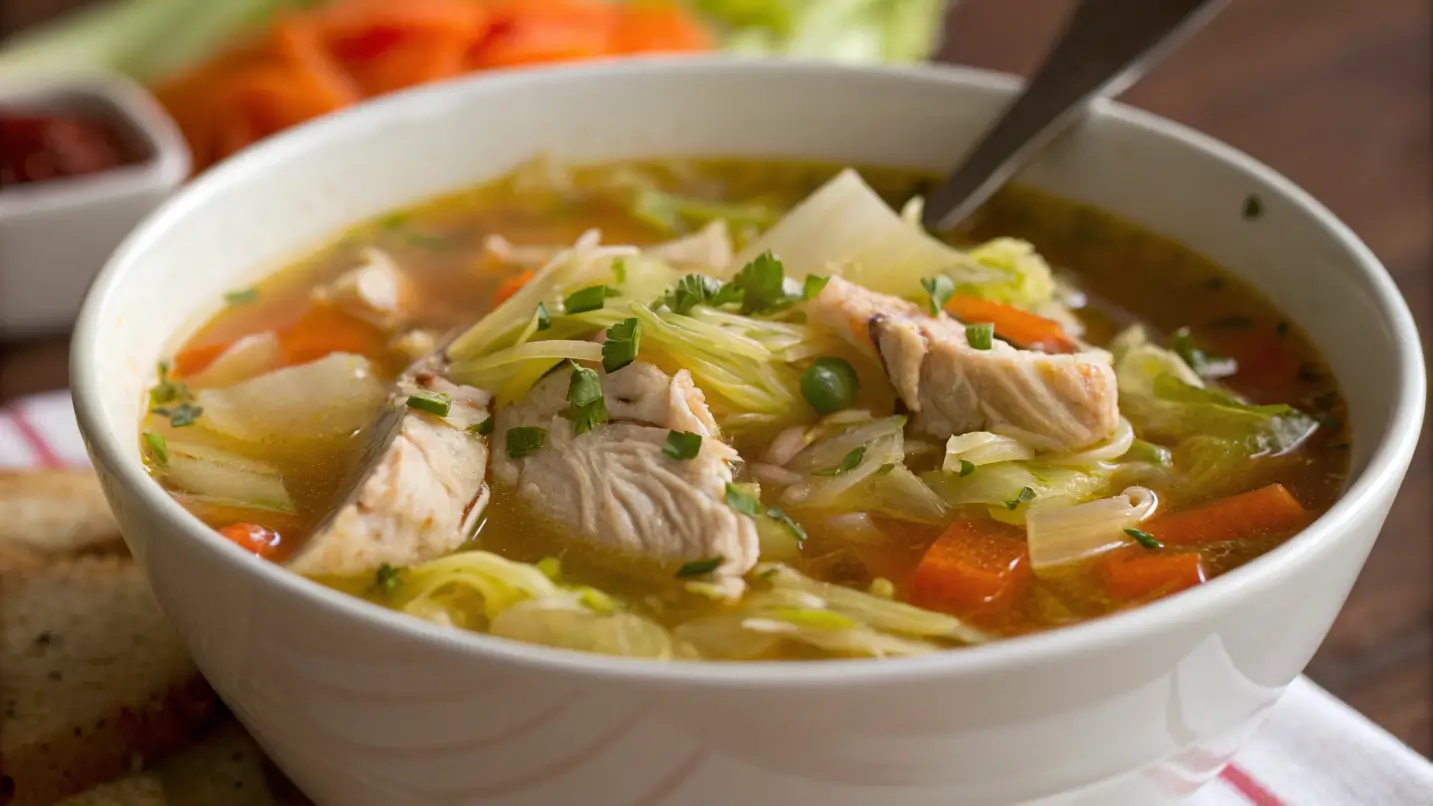
Building deep, rich flavors is key to a delicious chicken and cabbage soup. Here are some cooking techniques to take your soup to the next level.
Sautéing Aromatics: Building a Flavor Base by Properly Sautéing Onions, Garlic, and Spices
The first step in creating a flavorful soup is to sauté your aromatics—onions, garlic, and any spices or herbs—before adding the liquid. Sautéing these ingredients in a bit of oil or butter brings out their natural sugars and creates a savory base for the soup. Be sure to cook them over medium heat, stirring occasionally, until the onions become translucent and fragrant.
Deglazing: Incorporating Fond from the Pot to Enrich the Broth
After sautéing your vegetables, there will likely be brown bits (fond) left at the bottom of the pot. These bits are packed with flavor! Deglaze the pot by adding a bit of broth or water, scraping the bottom with a wooden spoon to loosen the fond. This will help incorporate those delicious flavors into the soup.
Balancing Acidity: Adjusting Flavors with Vinegar or Lemon Juice
Adding a splash of vinegar or a squeeze of lemon juice at the end of cooking can brighten up the soup and balance its richness. The acidity cuts through the fatty broth, enhancing the other flavors. Start with a small amount, taste, and adjust as necessary to achieve the perfect balance.
Storage and Reheating
Chicken and cabbage soup can be made in advance and stored for later. Here’s how to store it properly and reheat it without losing flavor or texture.
Proper Storage: Cooling and Storing Soup to Maintain Freshness
Allow your soup to cool to room temperature before storing it. This prevents condensation from forming in the container, which could make the soup soggy. Store the soup in an airtight container in the refrigerator for up to 3-4 days.
Freezing Tips: Guidelines for Freezing Without Compromising Texture
Chicken and cabbage soup freezes well. To freeze, allow the soup to cool completely, then transfer it to a freezer-safe container. Make sure there’s enough space for the soup to expand as it freezes. You can store it in the freezer for up to 3 months. When you’re ready to eat it, defrost it in the refrigerator overnight or reheat directly from frozen.
Want more tips on storing soups? Check out this guide from The Spruce Eats on freezing soups.
Reheating Techniques: Ensuring the Soup Retains Its Flavor and Consistency
To reheat the soup, place it in a pot over medium heat and stir occasionally. If the soup has thickened too much in the fridge or freezer, add a bit of broth or water to thin it out. Reheat until it’s heated through, making sure the flavors have melded together once again.
Frequently Asked Questions (FAQ)
Common Inquiries
Can I use frozen chicken for this soup?
Yes, you can absolutely use frozen chicken for this soup. If you’re using chicken breasts or thighs, simply add the frozen chicken directly to the pot with water or broth. You’ll need to increase the cooking time by about 10-15 minutes to ensure the chicken is fully cooked. However, if you’re using leftover rotisserie chicken or pre-cooked chicken, you can shred it and add it in the last 10 minutes of cooking, even if it’s frozen.
How do I make the soup spicier?
To add some heat to your chicken and cabbage soup, there are several ways to spice it up:
-
Add fresh chilies: You can add chopped jalapeños, serranos, or even dried chili flakes for a milder heat.
-
Hot Sauce: A dash of your favorite hot sauce can intensify the heat and add a layer of flavor.
-
Cayenne Pepper: If you like a bit of smoky heat, sprinkle in some cayenne pepper while cooking, starting with a pinch and adjusting to taste.
-
Spicy Seasoning: Adding chili powder, cumin, or chipotle can introduce both spice and depth to the broth.
What can I substitute for cabbage if I don’t like it?
If you don’t enjoy cabbage, there are several great substitutes you can use:
-
Kale: It offers a similar texture and is packed with nutrients.
-
Spinach: A softer, milder alternative, spinach wilts quickly into the soup.
-
Swiss Chard: This leafy green adds a similar bite to cabbage but with a slightly different flavor.
-
Collard Greens: A hearty alternative with a slightly bitter taste.
You can also use a combination of these greens if you’re looking to change things up!
Can I add pasta or rice to the soup?
Yes, you can definitely add pasta or rice to chicken and cabbage soup to make it more filling. If you add pasta, choose small shapes like ditalini or orzo to prevent the soup from becoming too heavy. For rice, add cooked rice during the last few minutes of cooking to avoid overcooking it. Both options will absorb the broth, making the soup heartier.
How long does the soup last in the refrigerator?
Chicken and cabbage soup can be stored in the refrigerator for 3-4 days in an airtight container. If you’re planning on keeping it longer, it’s best to freeze the soup. This will help preserve its flavors and texture for up to 3 months.
Conclusion
Recap and Final Thoughts
Chicken and cabbage soup is not only a warm, comforting dish but also an incredibly versatile and healthy option for any time of the year. With its rich blend of chicken, cabbage, and vegetables, it’s a well-rounded meal that offers numerous health benefits, from supporting your immune system to aiding digestion.
Whether you stick with the classic recipe or explore the many regional variations and dietary adaptations, there’s a chicken and cabbage soup recipe for every taste and lifestyle. The beauty of this dish lies in its adaptability—you can easily modify it to suit your preferences, experiment with different spices, or try new vegetables.
So, grab your ingredients, get cooking, and don’t be afraid to get creative. Find your perfect version of this comforting soup, and enjoy every hearty spoonful!
Print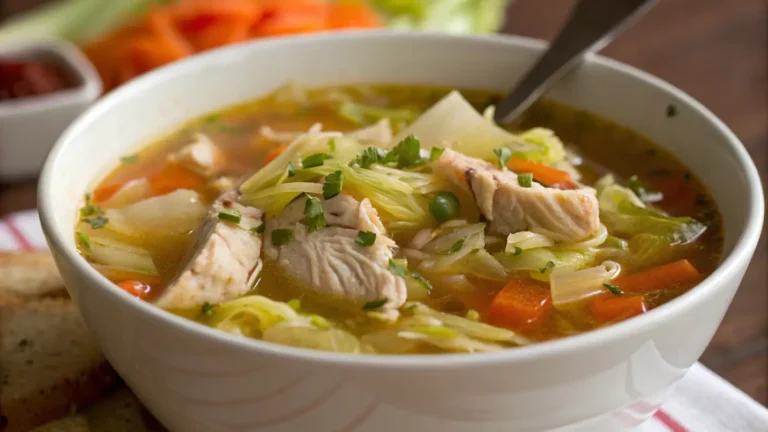
Chicken and Cabbage Soup
This hearty and nourishing Chicken and Cabbage Soup features tender chicken, crisp cabbage, and an array of vegetables, all simmered in a flavorful broth. The soup’s light yet satisfying flavor profile is balanced with aromatic herbs and spices, making it a comforting meal for any time of the year.
- Total Time: 45 minutes
- Yield: 4 servings 1x
Ingredients
2 chicken breasts or thighs (boneless, skinless)
4 cups chicken broth
1 medium head of cabbage, chopped
2 medium carrots, sliced
2 celery stalks, chopped
1 medium onion, chopped
3 cloves garlic, minced
1 tablespoon olive oil
1 teaspoon dried thyme
1 teaspoon dried oregano
1 teaspoon turmeric (optional, for added flavor and color)
1 bay leaf
Salt and pepper to taste
Fresh parsley (for garnish)
Instructions

-
Prepare the Chicken:
In a large pot, heat the olive oil over medium heat. Season the chicken breasts or thighs with salt and pepper. Add them to the pot and cook until browned on both sides, about 5-7 minutes. Remove the chicken from the pot and set it aside to cool. Once cooled, shred the chicken into bite-sized pieces. -
Sauté Vegetables:
In the same pot, add the chopped onion, carrots, celery, and garlic. Sauté for about 5 minutes until the vegetables begin to soften and the onions turn translucent. -
Add Broth and Seasoning:
Add the chicken broth to the pot along with the dried thyme, oregano, turmeric (optional), and bay leaf. Stir well to combine. -
Simmer the Soup:
Bring the soup to a boil, then reduce the heat to low and simmer for about 15-20 minutes, or until the vegetables are tender. -
Add Cabbage and Chicken:
Add the chopped cabbage and shredded chicken to the soup. Stir to combine, then continue to simmer for an additional 10 minutes, or until the cabbage is tender. -
Season and Serve:
Taste and adjust the seasoning with salt and pepper. Remove the bay leaf before serving. Garnish with freshly chopped parsley if desired. Serve hot.
Notes
- For a richer flavor, consider roasting the chicken before adding it to the soup.
- If you prefer a thicker soup, you can add a small potato, peeled and diced, during the simmering step.
- Feel free to adjust the vegetables based on what’s available or to your liking.
- Prep Time: 15 minutes
- Cook Time: 30 minutes
- Category: Main Course
- Method: Simmering
- Cuisine: American
- Diet: Low Calorie
Nutrition
- Serving Size: 1 bowl (approximately 1.5 cups per serving)
- Calories: 320
- Sugar: 6g
- Sodium: 800mg
- Fat: 12g
- Saturated Fat: 2g
- Unsaturated Fat: 8g
- Trans Fat: 0g
- Carbohydrates: 16g
- Fiber: 4g
- Protein: 32g
- Cholesterol: 90mg
Keywords: Chicken and cabbage soup, healthy soup recipe, low-carb soup, easy chicken soup, gluten-free soup, nutritious dinner
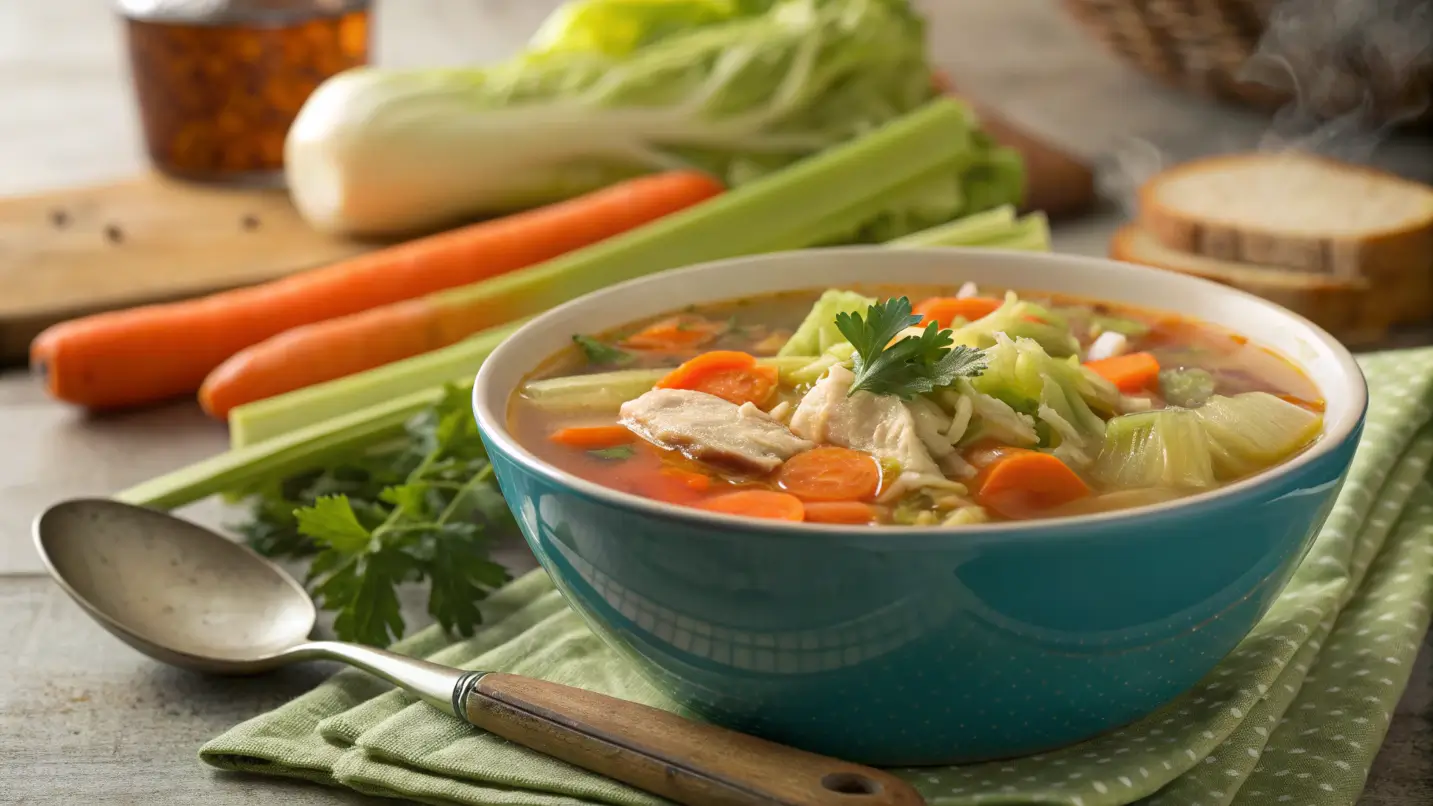


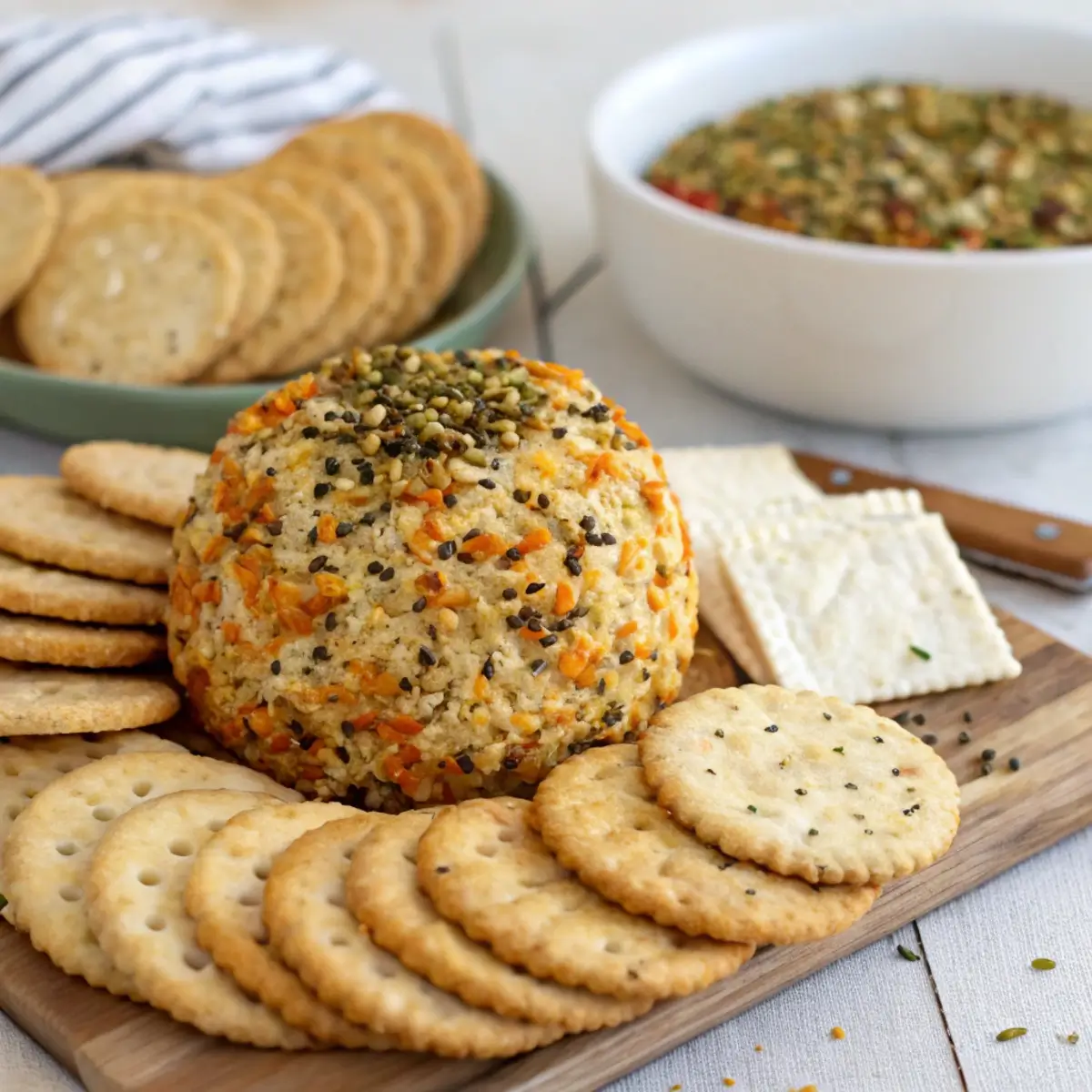


Yummy!
★★★★★